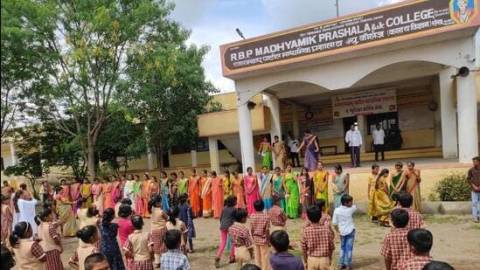
Why Maha kids on the border are forced to study in Kannada
Mumbai: On the border of Maharashtra and Karnataka is Sonalgi village, with a population of 2461. It does not have a single Marathi medium secondary school, which drives students to study in Kannada medium, after they emerge from Marathi medium primary schools. After clearing their Class VIII exams, they travel eight to 10 kilometers every day for further education.
This is the fate of the young ones in 29 villages and 79 wadis in Jath, one the three talukas on the border, where a large number of students are victims of the state government’s apathy.
As the Maharashtra-Karnataka border dispute has once again led to parleys between political parties, in a first, some villages have decided to join Karnataka.
“After the formation of Maharashtra in 1960, since there were Kannada speaking people in the border areas, Maharahtra government started around 1000 government and aided Kannada schools with the aim of holding them back in our state,” said Pandurang Patil, a trustee of an educational institute in Jath.
Schools were set up in the border areas of Akkalkot, Ichalkaranji, Pandharpur and Solapur districts. Patil said the schools get special grants from the neighbouring state government. The desire for Marathi medium schools in this area remains unfulfilled.
In 2012, when the border issue came up for discussion, the state government decided to open Marathi medium secondary and higher secondary schools in 101 villages and wadis on the areas bordering Karnataka. Soon, 156 applications were received for secondary schools in 21 villages of Jath taluka. The papers went back and forth for final approval till 2017. “When the Fadnavis-led government assumed office, all decisions to open Marathi medium schools were cancelled,” said Patil.
“I wanted my daughter to study in a Marathi medium school. But as she would have to travel 15 kilometers for higher education, we have put her in a Kannada school,” said a parent from Siddhanath village. “The state government here does not pay attention to Marathi medium schools. In fact, the Karnataka government provides special subsidy to Kannada medium schools here, making it the obvious choice for us.”
Sushil Shejule, coordinator of the Masterplan Action Committee, which follows up with Maharashtra government to set up schools on the border, said non-availability of Marathi medium schools has led to many parents making similar decisions.
Aid from Karnataka
For the last six decades the Karnataka government has been financially supporting Kannada medium schools located on the border areas of Maharashtra, doling out aid between ₹20-80 lakh per annum.
The RBP Madhyamik Prashala, in Sankh village, has a school with two sections, one where the medium of instruction is Marathi and another in Kannada. A teacher of the school, Shivaji Shinde, said despite an overload of Maharashtrian students, the school is reluctant to increase the sections, forcing students into Kannada medium.
“Funds disbursed to educational institutions by the Karnataka government are used to purchase uniforms and stationery. The Karnataka government also confers the ‘Gadinadu’ prize to meritorious students – another draw for them,” said Shinde.
This lacuna has driven most boys into farm labour after Class VIII, while girls are married off a few years thence.
“Parents of the girls switch them to Kannada medium after Class VIII to marry them off into Kannadiga families. Some boys move to neighbouring cities for career opportunities in Maharashtra,” said Praveen Naik, a teacher at a zilla parishad school at Siddhanath.
Why the neglect?
The demand for Marathi medium schools in the border areas has been longstanding since 14 years. “Governments change but the issue remains unresolved by leaders who are aware of it,” said Shejule. “If these villages have to be retained in Maharashtra, facilities to strengthen the education system must be introduced.”
Even as some villages in Maharashtra decided to go to Karnataka, through a gram sabha resolution recently, there are 865 villages on the Karnataka border that have wanted to join Maharashtra for the last 62 years. “Maharashtra has not paid attention to their desire,” said Narayan Kaporkar, president of Marathi Sanskrutik Pratishthan-Khanapur, which works to promote Marathi language and culture in the border areas.
Interestingly, while the government of the neighbouring state grants special subsidy to Kannada medium schools in border areas of Maharashtra, Marathi schools are closing down. Since the 1960s, approximately 450 Marathi medium schools have shut down in Karwar and Hallyal areas; at present there are 228 Marathi schools in Khanapur area.
On two occasions – between 2011 and 2012, and 2019 – the state government promised to give ₹3 crore and ₹5 crore respectively to Marathi medium schools on the Karnataka border area. “Till date, we haven’t received the single penny,” said Kaporkar.
Sign on to read the HT ePaper epaper.hindustantimes.com